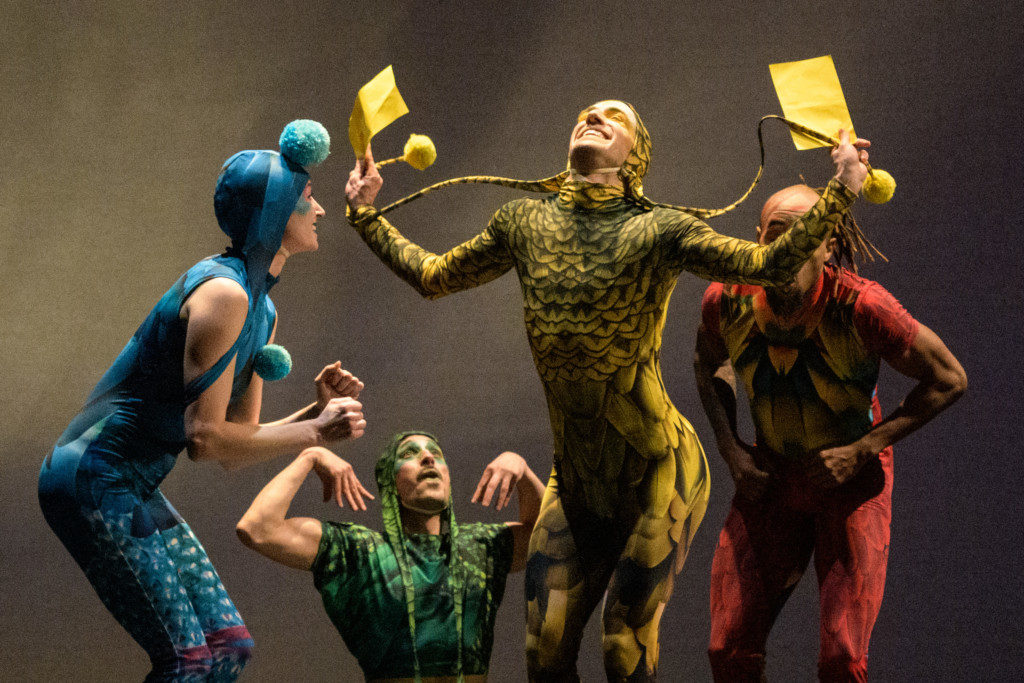In the second chapter of his 1994 book Pale Blue Dot: A Vision of the Human Future in Space, Carl Sagan wrote about the “human-centered conceit” and the work of Copernicus and Galileo proposing to “displace us from cosmic center stage.” It was the image of the earth as a mere orbiting dot that the unmanned Voyager 1 spacecraft provided as it scanned the Solar System from its outer edges (incidentally, Voyager 1, launched 43 years ago, is now more than 13.8 billion miles from the planet).
In the 18th century, the British astronomer James Bradley accidentally discovered the aberration of light demonstrating that, indeed, the Earth revolved around the Sun, which was confirmed in the 19th century with direct observation of stars in the sky. “It pounded the final nail into the coffin of geocentrism,” Sagan wrote. “You need only look at your finger with your left eye and then with your right and see it seem to move. Everyone can understand parallax.”
Daniel Charon, choreographer and artistic director of Ririe-Woodbury Dance Company, always has been fascinated by technology, science fiction and science as much as he is by his passion for dance. In recent seasons, the books and scientific knowledge he has encountered has shaped several memorable world premieres of his dance works by the company.
For example, thematic dimensions of parallax as Sagan described it translated well to Ririe-Woodbury’s opening concert of the 54th season in 2017. In that concert, as noted in the time at The Utah Review, “It was riveting not just to see how artists in the dance world envision their creative possibilities but also for how audiences might see in themselves the various emotional, social and cultural dimensions that inspired the evening’s work.”

His latest work, Aberrations of Light, will premiere in Ririe-Woodbury’s Allegory concert (Jan. 31 – Feb. 1). And, Charon builds the piece from Sagan’s sentiment, as expressed in the book, “No longer confined to a single world, we are now able to reach out to others and determine decisively what kind of planetary system we inhabit.”
Charon says the company’s six dance artists and 11 dancers from Utah Valley University have been involved extensively in the process. Together, they have set movement to various manifestations of landscapes and how much our intuitive understanding of parallax and the aberrations of light shapes the view we create in our world and our surroundings. “The work is not a linear narrative but more like a book of poetry,” he adds.

With 17 dancers on stage, the combinations expand the opportunities for the movement language driving Aberrations of Light. The moments for introspection and transcendence occur as humanity crosses landscapes and confronts the existential challenges of keeping and improving the fragile balance we have with the planet and its natural surroundings.
Charon also incorporates elements that echo Voyager 1’s enormous contributions to our understanding of astronomy and what deep space really means. There will be video images, including the iconic “pale blue dot,” and the work’s ambient soundscape riffs off the samples of sound and music that scientists placed in the probe, should any other civilization ever discover it. Melissa Younker, one of the company’s dance artists, designed the costumes for the work.
In an artistic statement for Aberrations of Light, Charon says, ““I think that the care for our environment is probably the most important issue our world faces as we move into the future. Everything else we do, who we are, and who we will become stems from how we confront global environmental issues now. He adds, “I feel fortunate that dance can be a medium that can consider such a crucial issue and help to create an awareness that can provoke change.”
The Allegory concert also will feature the restaging of a 2019 premiere of the live creature and ethereal things, a magnificent collaboration with the Flying Bobcat Theatrical Laboratory and the Red Fred Project. Graham founded the project, which gives children with rare diseases and chronic illness the opportunity to create a book, and characters and stories from the series animate the work.

As The Utah Review noted in a review at the time of last year’s premiere, “This artistic collaboration succeeded for its unrestrained joy, a feeling shared among every participant. Indeed, it is a piece like the live creature and ethereal things that reminds us how creative work for family and children is as significant and valuable and artistic achievement as those that convey the most profound elements of dramatic emotion.”
With the storyline guidance of Alexandra Harbold from the Flying Bobcat Theatrical Laboratory, an original musical score by John Paul Hayward, and text and lyrics by New York playwright Troy Deutsch, the work brings to life in dance the characters of the Jolly Troop that form the core of the stories created in the Red Fred Project.

The most significant changes in the work, which will be shorter and tighter than its original version, include a new guest artist, Tito Livas, taking over the role from Robert Scott Smith, who appeared in the 2019 premiere. Livas’ fluency in Spanish has expanded the bilingual nature of the work, which is suited to family audiences of all ages. As Charon explains, “Tito not only brings inspiring musical theater talent to the production, but also enables the company to continue to develop its bilingual programming as a way to be more inclusive to our local Spanish speaking community.”
There also will be animated video projections created by Nicolas Ridruejo that enhance the children’s storybook flavor of the work.

Performances will be Jan. 31 and Feb. 1 at 7:30 p.m. in the Janet Quinney Lawson Capitol Theatre in downtown Salt Lake City. In addition, a one-hour matinee performance, part of the company’s Moving Parts Family Series, will be offered on Feb. 1 at 1 p.m. The matinee performance is open to families, including “babes in arms,” and features condensed versions of the evening concert works along with an opportunity to meet the dancers after the concert.
For more information and tickets, see ArtsSaltLake.org and here for family matinee tickets.
